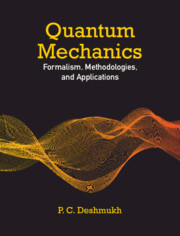Book contents
- Frontmatter
- Dedication
- Contents
- List of Figures
- Foreword
- Preface
- 1 Description of a Physical System
- 2 Path Integral Formulation of Quantum Mechanics
- 3 Probability Tangles and Eigenstates of One-dimensional Potentials
- 4 Angular Momentum
- 5 The Non-relativistic Hydrogen Atom
- 6 Approximation Methods
- 7 The Relativistic Hydrogen Atom
- 8 Quantum Mechanics of Spectral Transitions
- 9 The Many-Electron Atom
- 10 Quantum Collisions
- 11 Introduction to Quantum Information and Quantum Computing
- Appendix A Symmetry of the Hamiltonian
- Appendix B Schrödinger, Heisenberg, and Dirac “Pictures” of Quantum Dynamics
- Appendix C Spherical Harmonics
- Appendix D Occupation Number Formalism Second Quantization
- Appendix E Electron Structure Studies with Qubits
- Index
10 - Quantum Collisions
Published online by Cambridge University Press: 14 September 2023
- Frontmatter
- Dedication
- Contents
- List of Figures
- Foreword
- Preface
- 1 Description of a Physical System
- 2 Path Integral Formulation of Quantum Mechanics
- 3 Probability Tangles and Eigenstates of One-dimensional Potentials
- 4 Angular Momentum
- 5 The Non-relativistic Hydrogen Atom
- 6 Approximation Methods
- 7 The Relativistic Hydrogen Atom
- 8 Quantum Mechanics of Spectral Transitions
- 9 The Many-Electron Atom
- 10 Quantum Collisions
- 11 Introduction to Quantum Information and Quantum Computing
- Appendix A Symmetry of the Hamiltonian
- Appendix B Schrödinger, Heisenberg, and Dirac “Pictures” of Quantum Dynamics
- Appendix C Spherical Harmonics
- Appendix D Occupation Number Formalism Second Quantization
- Appendix E Electron Structure Studies with Qubits
- Index
Summary
How wonderful that we have met with a paradox. Now we have some hope of making progress
—Niels BohrProbing an elementary or composite particle, an atom, an ion, a molecule, a cluster, or, for that matter any quantum system, involves studying how the target responds to a query – an investigation that is made using a probe that could be electromagnetic radiation (a photon or a beam of light that is incident on the target), or impinging the target with some particles, such as electrons, positrons, neutrons, α-particles, or composites of the same such as atoms, ions, and molecules. Typically, the investigation is called “spectroscopy” when the probe is electromagnetic radiation that is absorbed, scattered or reemitted by the target, which is the object of investigation. When the probe is some other particle, it is usually called “collisions.” The quantum mechanics of spectroscopy and collisions is, however, very closely and seamlessly related, as we shall uncover in this chapter. Niels Bohr's remark quoted above in the frame of a diagram depicting collisions signposts the fact that studies of quantum collisions have resulted in many landmark developments in physics.
10.1 Partial Wave Analysis, Faxen–Holstmark Equation for Potential Scattering
Very commonly, quantum collisions are analyzed using what is called as partial wave analysis, which is a mathematical framework developed by Hilding Faxen and Johan Holtsmark in 1927 [1–4]. The Faxen–Holtsmark theory aims at investigating a target T using a monoenergetic incident beam of projectile particles P. Figures 10.1a–d schematically illustrate the scattering process. A monoenergetic beam of incident particles represented by a wavepacket in Fig. 10.1a enters an apparatus containing the target atoms. The polar axis of this coordinate frame is the Z-axis of a Cartesian coordinate system that is chosen to be along the direction of incidence of the probe particles – also referred to as projectiles. Information about the target is obtained from the interaction between the projectiles and the target. The probability of encounter between the incident and the target particles is of primary interest in the scattering formalism. A measure of the encounter probability is provided by the ratio
The flux of the incident particles is
where NP is the number of probing particles reaching the target per unit time, and S is the effective cross-sectional area of the incident beam that enters the apparatus through the collimator.
- Type
- Chapter
- Information
- Quantum MechanicsFormalism, Methodologies, and Applications, pp. 451 - 506Publisher: Cambridge University PressPrint publication year: 2024



